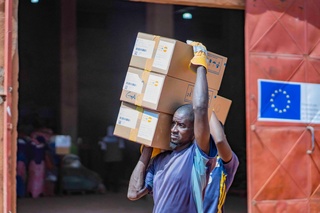share

Unloading a river convoy of humanitarian supplies in Mali in 2023. | © T. N’Daou / HI
With the support of the European Union, HI provides other NGOs in Mali with a road and river transport solution for delivering their aid to communities in need.
In 2023, an estimated 8.8 million Malians were in need of humanitarian assistance1. However, the country’s deteriorating security situation has made it increasingly difficult for humanitarian actors to deliver aid. To help with this situation, HI is providing other NGOs operating in the country with a free transport service – funded by the European Union – that ensures their aid reaches even the most remote villages. Seydou Diallo works for HI as a driver assistant: he accompanies these aid convoys to make sure the supplies arrive safely.
 Seydou Diallo began working as a driver assistant for HI in 2020. His role is to be present at every stage of the convoy. He assists with the loading of goods in the departure town and makes sure that everything is in order (quantity, weight of packages, etc.). Then, he helps the drivers of the local companies contracted by HI to liaise with the teams of the client organisation. Once at destination, he supervises the unloading of the equipment.
Seydou Diallo began working as a driver assistant for HI in 2020. His role is to be present at every stage of the convoy. He assists with the loading of goods in the departure town and makes sure that everything is in order (quantity, weight of packages, etc.). Then, he helps the drivers of the local companies contracted by HI to liaise with the teams of the client organisation. Once at destination, he supervises the unloading of the equipment.
"When I started working with HI, I was unemployed. I applied for the job to earn some extra money and cover my household expenses. Later, I had the opportunity to do more stable jobs, but HI never dropped me. I was still able to do one or two convoys a month. When I wasn't available, HI would let me get on with my other jobs and as soon as I was available again, I would let them know. This way of working has suited me very well; I really appreciate it.”
Seydou has seen some changes since he first started his job. At first, there were some problems to sort out, such as when the goods to be transported were not the ones received for loading. But today, everything runs smoothly and Seydou works with teams who are used to working together and who get on well.
In 2023, HI trained 400 people working on its convoys, including drivers, load handlers and driver assistants. The training covered humanitarian access, the risk and security management of transport in Mali, as well as the humanitarian supply chain. HI’s teams also ran risk education sessions, so that participants could identify dangerous situations and would know how to behave in the sensitive areas to which they travelled.
"The fact that HI doesn’t have its own vehicles and only uses local transporters is a plus for the population. It helps to boost Mali’s economy and provide jobs, and I think that's important. It's a win-win situation," says Seydou.
 In Mali, HI has developed logistical expertise and in-depth knowledge of the field and its actors. It puts this knowledge to use transporting humanitarian goods (medical supplies, food, etc.) by road and river for other NGOs. In a country where the security situation is particularly complex, HI delivers these supplies to the most remote villages, where they are then distributed to the communities by the NGOs using the platform's transport services.
In Mali, HI has developed logistical expertise and in-depth knowledge of the field and its actors. It puts this knowledge to use transporting humanitarian goods (medical supplies, food, etc.) by road and river for other NGOs. In a country where the security situation is particularly complex, HI delivers these supplies to the most remote villages, where they are then distributed to the communities by the NGOs using the platform's transport services.
"It's the HI teams who tell us when we can leave and keep us up to date with the situation on the road. For my part, I keep them informed of the convoy’s progress. I'm HI's eyes and ears in the convoy, so I've gradually taken on more responsibility over the course of the project," explains Seydou.
In 2023, despite the many access problems, HI transported around 1,200 tonnes of humanitarian aid via 165 road operations and 15 river operations. This safe, fast and cost-effective service was used by more than 40 organisations.
 This supply and transport project is being implemented with the support of the European Union. The European Union and its Member States are the world's leading donors of humanitarian aid: https://civil-protection-humanitarian-aid.ec.europa.eu.Through its Civil Protection and Humanitarian Aid Operations department (ECHO), the European Union helps millions of victims of conflicts and disasters every year. With headquarters in Brussels and a global network of field offices, the EU provides assistance to the most vulnerable people on the basis of humanitarian needs.
This supply and transport project is being implemented with the support of the European Union. The European Union and its Member States are the world's leading donors of humanitarian aid: https://civil-protection-humanitarian-aid.ec.europa.eu.Through its Civil Protection and Humanitarian Aid Operations department (ECHO), the European Union helps millions of victims of conflicts and disasters every year. With headquarters in Brussels and a global network of field offices, the EU provides assistance to the most vulnerable people on the basis of humanitarian needs.
However, the views and opinions expressed are those of HI only and do not necessarily reflect those of the European Union. Neither the European Union nor the granting authority can be held responsible for them.








HI is an independent and impartial aid organisation working in situations of poverty and exclusion, conflict and disaster. We work alongside people with disabilities and vulnerable populations, taking action and bearing witness in order to respond to their essential needs, improve their living conditions and promote respect for their dignity and fundamental rights.
HI is an independent and impartial aid organisation working in situations of poverty and exclusion, conflict and disaster. We work alongside people with disabilities and vulnerable populations, taking action and bearing witness in order to respond to their essential needs, improve their living conditions and promote respect for their dignity and fundamental rights.